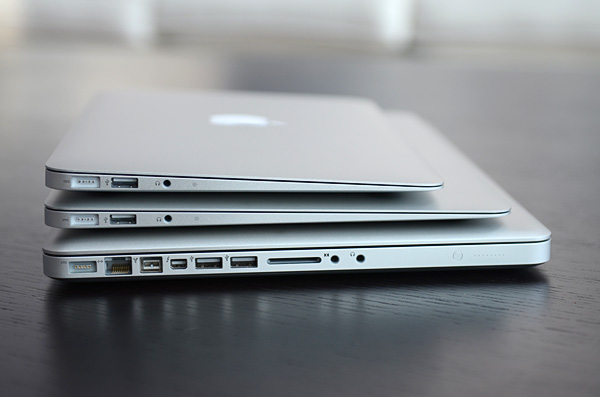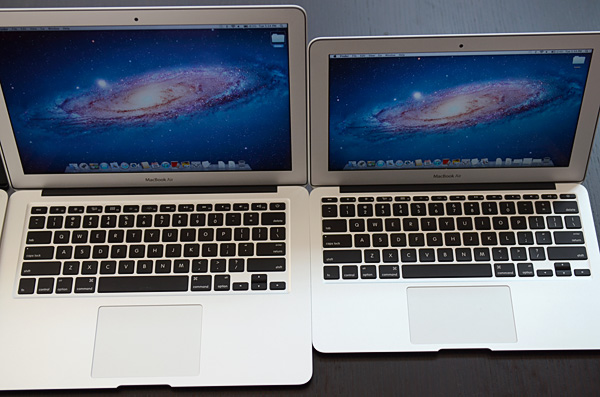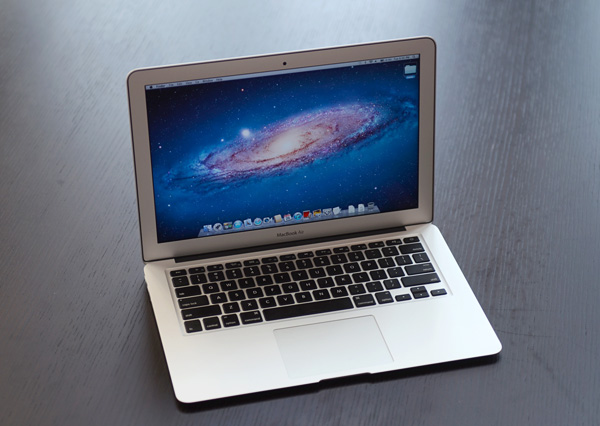The 2011 MacBook Air (11 & 13-inch): Thoroughly Reviewed
by Anand Lal Shimpi on July 28, 2011 3:25 AM EST- Posted in
- Apple
- Mac
- Intel
- Sandy Bridge
- MacBook Air
- Laptops
The 11
The 11-inch MacBook Air comes with a 1366 x 768 display (16:9) measuring 11.6-inches along the diagonal. Ports and features are near identical to last year's model. Up top there's a 640 x 480 camera. Along each side is a USB 2.0 port. Mag Safe and headphone jack are on the left, while Thunderbolt is on the right. There's a single fan inside the chassis that vents between the keyboard and the display hinge.
The 11 is still an amazing form factor. It's painless to carry around and you end up with a tablet sized device that makes no functional sacrifices. To make things even better, now you get a full blown Sandy Bridge CPU inside the ultra slim chassis.
There are really only two things that the 11-inch MacBook Air lacks. For starters, the lack of an integrated SD card reader means anyone looking to do photo work on the go will either need an Eye-Fi or an external USB card reader. Neither is too much of a pain however an integrated reader would be much appreciated.
The second issue with the 11 is its screen size/resolution. At 1366 x 768 you get great pixel pitch on the 11-inch 16:9 screen but there's just not a lot of vertical resolution on the display. The 13-inch model gives you only 5% more horizontal resolution but 17% more vertical, and that's noticeable.
Lion does alleviate some of this problem thanks to its full screen mode. Viewing Mail or Safari in full screen is almost necessary on the 11. Thanks to the 16:9 ratio of the panel, watching movies on the 11 is nearly equivalent to watching them on the 13-inch Air.
The base $999 configuration only comes with 2GB of DDR3 and a 64GB SSD. The latter is excusable if you just don't do much with your system (and technically it's something you can upgrade down the line if you'd like) but the former is a major problem. Memory on the MacBook Air is soldered directly onto the motherboard. Not having to build in a socket helps keep the z-height of the system down to a minimum, but it also severely limits flexibility. For most users interested in a dual-core machine under OS X I'd say that 4GB is probably good enough. While I'd prefer the option of upgrading to 8GB, I think 4GB is livable; 2GB is not. If you're considering the entry-level 11-inch MacBook Air I'd strongly recommend at least upgrading the memory to 4GB. The only exception is if you're just going to spend your time doing very basic tasks on the machine and plan on upgrading again in a year or two. If that's the case save your money and enjoy a 4GB version with Ivy Bridge next year. For everyone else, make sure you get the memory upgrade.
The 13
While the 11 is almost tablet-like, the 13-inch MacBook Air still looks and feels like a normal notebook. A really thin, really light notebook. You get a 1440 x 900 (16:10) display that measures 13.3-inches along the diagonal. The port layout is identical to the 11 although you get an integrated SD card reader along the right of the machine.

From top to bottom: 11-inch MacBook Air, 13-inch MacBook Air, 15-inch MacBook Pro
The 13 is really a pleasure to use, despite feeling a lot like a traditional notebook. The biggest difference for me between it and the 11 is the height of the display. Seated on a couch with the notebook in my lap the 13 doesn't force me to look down as much to see the screen. I still have to tilt my head down a bit, just not as much as with the 11.
The 13-inch screen maintains a relatively high pixel density, just shy of the 128 pixels per inch you get from the 15-inch MacBook Pro with the upgraded 1680 x 1050 display. I find the 13 is a bit easier to look at than the 11 with its 135 PPI display, but that's a personal preference. Apple really needs to increase the resolution of its 13-inch MacBook Pro which is a paltry 1280 x 800.

13-inch MacBook Air (left) vs. 11-inch MacBook Air (right)
The 13's base configuration is actually really good. You get 4GB of memory (neither Air supports more than 4GB of RAM) and a 1.7GHz Core i5. The 1.7GHz part here is a bit more interesting than the 1.6GHz chip in the 11 because it supports much higher max turbo frequencies (2.4/2.7GHz vs. 2.0/2.4GHz). If you don't need more than 128GB of internal storage, my recommendation would be to go for the base 13 at $1299.











103 Comments
View All Comments
darwinosx - Saturday, July 30, 2011 - link
There is barely any difference between Elitebook models to talk about. Nor is there anything particularly special about them. Just another Windows clone made and supported a little better than what HP sells at Best Buy. Given that, it was covered quite well.OCedHrt - Thursday, July 28, 2011 - link
This is so last year. This is not even what I got in my Sony Z last year. For $1600. 2.4 ghz i5 (520m), GT 330M in 3 lb chasis with internal dvdrw. And that was bottom of the line. Not to mention I got mine from MSFT with 40% off.This year: http://store.sony.com/webapp/wcs/stores/servlet/Ca...
Of course this one costs way more, but still worth a though.
beginner99 - Thursday, July 28, 2011 - link
lol yeah. Sony is the only brand that has even more ridiculous pricing than Apple. You say it yourself 40% off. And in this case I say apple's pricing is very competitive and I'm an "apple-hater". Never owned a single device from them, not even an Ipod.The new base model Vaio Z will also be about 40% more expensive at half of the SSD capacity.
Anyway, I would have already bought it, if it was a windows system.
Johnmcl7 - Thursday, July 28, 2011 - link
I wouldn't say Sony's pricing is ridiculous as you're paying for absolutely cutting edge tech whereas with Apple . The previous Z series may have been pricey but it featured a 13.1 1080p screen (genuine 1920x1080), up to an i7 dual core processor, quad SSDs in RAID 0, dual graphics graphics cards (one integrated, one discrete), blu-ray writer which even Apple's 17in machines couldn't match but was smaller and lighter than Apple's 13in machines.I have the Vaio from the previous generation (Z5) which has a C2D 3Ghz processor, 13.1 1600x900 screen, dual 128GB mSSDs in RAID 0, blu-ray writer and integrated & discrete graphics cards which again Apple didn't offer anything even remotely comparable. Speccing up a Macbook to the maximum level put it far above the Vaio in cost but far below in spec with just a 2.6Ghz processor, DVD burner, single graphics card and low resolution screen.
John
darwinosx - Saturday, July 30, 2011 - link
Kids, read the review and learn something before commenting. No Sony has this proc in it yet. Also learn something about cpu speed in different processor models. Finally try to understand that this laptop is meant to be super thin and lightweight which the Sony is not. It is also top quality construction support and uses a modern OS.OCedHrt - Tuesday, August 2, 2011 - link
The sony from last year is nearly the same weight at 3.1 lb with an internal optical drive and the new one this year is much lighter at 2.5 lbs with external.The Sony Z specifically do not use ULV processors for maximum performance:
Intel® Core™ i5-2410M processor (2.30GHz) with Turbo Boost up to 2.90GHz
Intel® Core™ i5-2540M processor (2.60GHz) with Turbo Boost up to 3.30GHz
Intel® Core™ i7-2620M processor (2.70GHz) with Turbo Boost up to 3.40GHz
The base processor already matches the top of the line Air processor in turbo and far exceeds it in other conditions.
So to recap: Sony Z from last year (Z11-Z14) is already super thin and light weight at significantly faster performance for same cost, and sometimes cheaper when Microsoft Store has a crazy sale.
Sony Z for this year Z21 is even thinner and lighter at even faster performance for a slight premium. Remember the lowest Z performs better than the fastest Air. $1969 vs $1599 gives you an external dvdrw and discrete graphics and usb 3.0. That's not a bad deal at all.
Keep in mind the fastest Z will kill the Air in performance all in the same chasis. And battery life from reviews indicate the new Z is on-pair with Air (4+ hours with a movie playing continouously).
OCedHrt - Tuesday, August 2, 2011 - link
$1600 was not 40% off. I got mine for $1100. $1600 is the retail price at B&M for the entry level model that I outlined (with 64gb x2 SSD).ViRGE - Thursday, July 28, 2011 - link
Looking at the specs, something doesn't make sense. They're using 35W TDP processors and claiming better battery life on a smaller battery than the 13" MBA. The math doesn't add up on that one.KPOM - Thursday, July 28, 2011 - link
Might Sony be including the optional "sheet battery" in that time?ViRGE - Thursday, July 28, 2011 - link
Nope. They break that out separately.